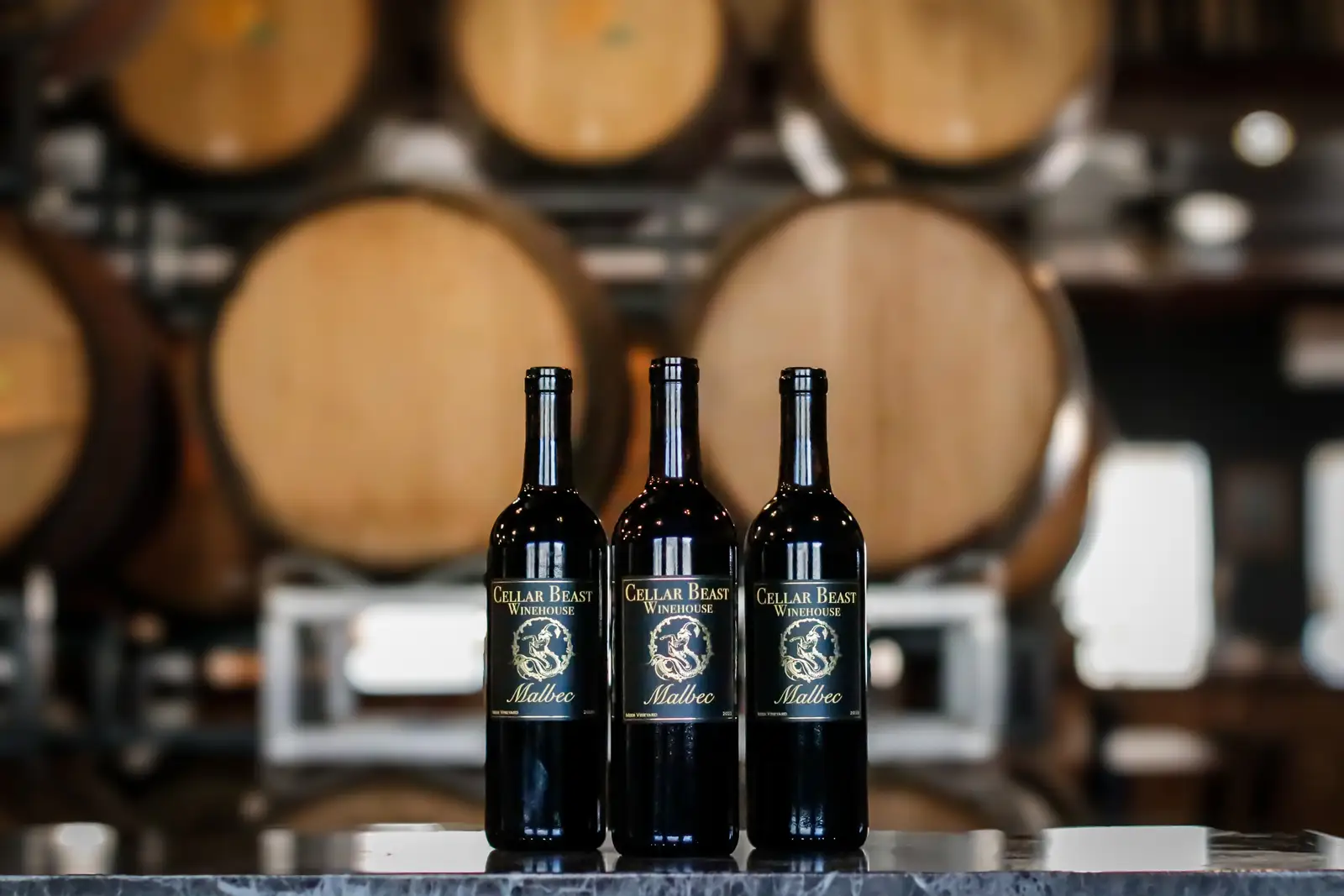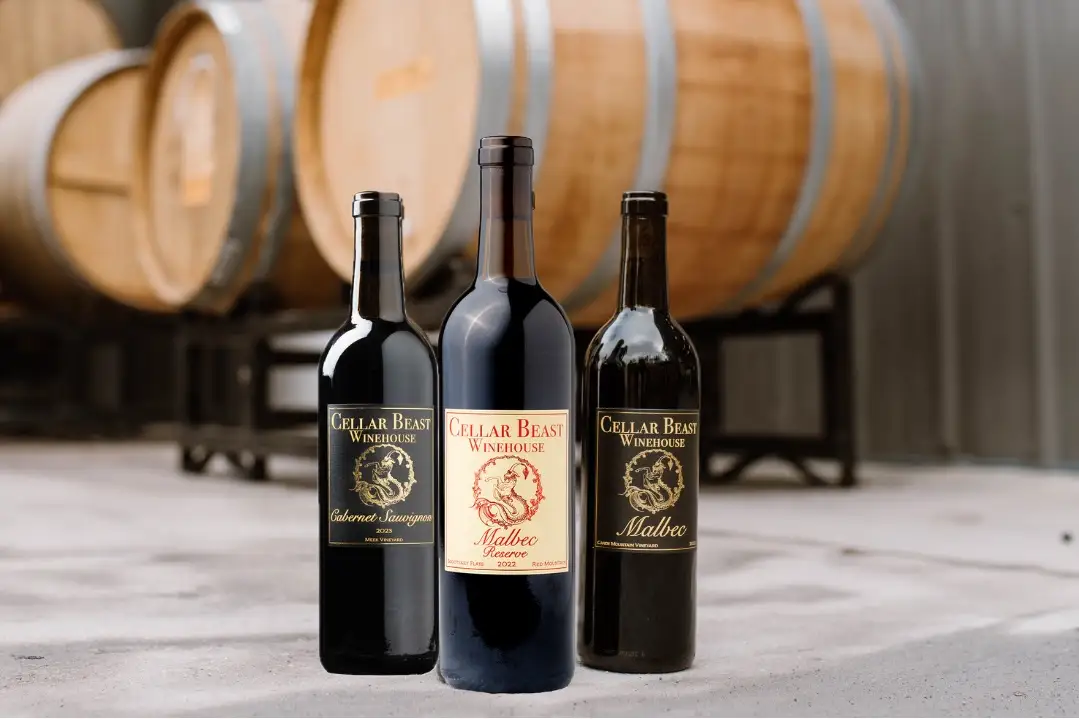Oak aging is one of the most influential techniques in winemaking, shaping the aroma, texture, and longevity of a wine. Far more than a vessel, oak barrels contribute to the wine’s flavor profile, soften its structure, and add layers of complexity. Winemakers use oak to enhance a wine’s balance, deepen its character, and create wines that can age gracefully over time.
At Cellar Beast Winehouse, we are passionate about crafting wines that honor tradition while showcasing precision and intention. Our wines are aged using carefully selected barrels—from neutral to new, and from tight-grain French oak to bold American oak—each chosen to match the varietal and vintage. These oak vessels play a defining role in the final character of the wines you experience in our tasting room or take home to your cellar.
Explore our oak-aged wines and tasting experiences, and learn more about our winemaking techniques here.
What Is Oak Aging in Wine?
Oak aging refers to the practice of fermenting or maturing wine in oak barrels, a tradition that dates back thousands of years. Ancient civilizations used wooden vessels for storage, but it was the Romans who popularized oak specifically for its workability, durability, and positive influence on wine.
Today, winemakers often choose oak over stainless steel or concrete when seeking to add texture, integrate tannins, or infuse nuanced flavors into their wine. While fermentation in oak is used occasionally—especially for whites like Chardonnay—most oak influence occurs during maturation, when wine spends months (or years) developing in barrel.
The Types of Oak Used in Winemaking
French oak is prized for its tight grain and subtle influence—think refined spice, toast, and elegance. It’s expensive, but delivers finesse that complements structured reds and full-bodied whites.
American oak has a wider grain and imparts more pronounced flavors: vanilla, coconut, and sweet spice. Its bold personality makes it ideal for varietals like Zinfandel and Tempranillo.
Hungarian and Eastern European oaks are gaining favor for their moderate cost and nuanced spice. Often similar to French oak in structure, they offer a middle ground for winemakers to work with.
Toasting levels—light, medium, heavy—play a critical role. A light toast preserves wood tannins and spice, while heavier toasts introduce char, smoke, and caramelized sweetness.
How Oak Aging Affects Wine Flavor and Texture
Oak can transform a wine’s flavor profile. Expect aromas and flavors such as vanilla, clove, cedar, coconut, dill, and baking spice. Toasted barrels might add hints of smoke or espresso.
Texture-wise, oak aging integrates tannins and adds roundness. It can smooth out youthful astringency and lend a plush, structured mouthfeel. In red wines, oak helps stabilize color and preserve longevity. In whites, oak adds creaminess and aromatic depth.
Length of Oak Aging — How Time Changes Everything
Wines aged briefly (3–6 months) tend to pick up subtle oak influence. Medium aging (6–12 months) allows for flavor integration, while long aging (18–36+ months) introduces deeper complexity—but with risk.
Too much time in new oak can overpower fruit, leading to wines dominated by wood rather than balance. The key is matching barrel age and toast level to grape variety and desired style.
Meanwhile, barrels allow micro-oxygenation—a slow ingress of air that softens tannins and builds texture over time.
The Role of Oak Grain and Barrel Size
Grain matters. Tight grain (as in French oak) slows the release of flavor and ingress of oxygen, resulting in a subtle influence. Loose grain (like American oak) imparts stronger flavors more quickly.
Barrel size also affects the outcome. Smaller barrels (such as 225L barriques) expose more wine to wood, thereby increasing the oak's impact. Larger barrels (like 500L puncheons) offer more restraint.
New oak provides the most intense influence, while “neutral” barrels (used 2–3 times) allow for gentle aging without strong flavor contribution.
Oak Aging at Cellar Beast Winehouse
At Cellar Beast, oak aging is approached with precision. We use a variety of French oak barrels, including both new and neutral, to match each varietal’s personality. For our Rhône-style blends, we often opt for neutral barrels to preserve the freshness of the fruit. For Bordeaux-style reds and varietals, such as Sangiovese or Carménère, new French oak adds spice, texture, and age-worthiness.
Our 2022 "Jeune Bête" (Grenache/Syrah), aged in neutral French oak, exhibits vibrant red fruit and herbal complexity. Our "Dark Angel" blend of Carménère and Petit Verdot, aged in 26% new French oak, offers a layered profile of spice, structure, and a long, elegant finish.
Book a Guided Tasting to Explore Barrel Impact
Tasting and Pairing Oak-Aged Wines
Oak-aged wines are versatile at the table. Their spice and structure pair beautifully with grilled meats, aged cheeses, and umami-rich ingredients like mushrooms or truffles.
To taste the oak’s impact, use the swirl-sniff-sip method:
- Swirl to release aromatics
- Sniff for spice, toast, vanilla, or smoke
- Sip to sense mouthfeel and tannin integration
Serve reds around 60–65°F. Decant young or highly oaked wines to allow flavors to harmonize.
Conclusion
Oak aging remains one of the most essential techniques in fine winemaking. It shapes the wine’s identity from aroma to finish, and when done thoughtfully, enhances both drinkability and longevity.
Explore the diversity of oak-aged wines at Cellar Beast, from bold and structured to bright and nuanced.
Book a Tasting to Compare Barrel-Aged Wines
About the Author: Matt Check
Matt Check is the Head Winemaker at Cellar Beast Winehouse, where his expertise in Old World winemaking techniques meets a relentless curiosity for innovation. With over a decade of experience spanning vineyard management, fermentation science, and cooperage selection, Matt leads Cellar Beast’s barrel program with surgical precision.
A champion of thoughtful oak use, Matt believes in honoring the varietal first—then selecting barrels that elevate the wine without overshadowing it. His choices are guided by vintage conditions, vineyard expression, and a deep understanding of how grain, toast, and barrel age shape wine over time.
When he's not racking wine or fine-tuning blends in the cellar, you’ll find Matt leading private tastings, where he breaks down the nuances of oak in a way that’s both accessible and deeply informed. His palate and philosophy are behind every oak-aged release at Cellar Beast.




